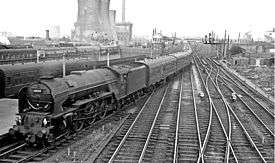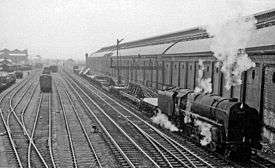Darlington railway station
| Darlington | |
|---|---|
 | |
| Location | |
| Place | Darlington |
| Local authority | Borough of Darlington |
| Coordinates | 54°31′15″N 1°32′47″W / 54.5209°N 1.5464°WCoordinates: 54°31′15″N 1°32′47″W / 54.5209°N 1.5464°W |
| Grid reference | NZ294140 |
| Operations | |
| Station code | DAR |
| Managed by | Virgin Trains East Coast |
| Number of platforms | 4 |
| DfT category | B |
|
Live arrivals/departures, station information and onward connections from National Rail Enquiries | |
| Annual rail passenger usage* | |
| 2010/11 |
|
| – Interchange |
|
| 2011/12 |
|
| – Interchange |
|
| 2012/13 |
|
| – Interchange |
|
| 2013/14 |
|
| – Interchange |
|
| 2014/15 |
|
| – Interchange |
|
| National Rail – UK railway stations | |
| * Annual estimated passenger usage based on sales of tickets in stated financial year(s) which end or originate at Darlington from Office of Rail and Road statistics. Methodology may vary year on year. | |
|
| |
Darlington railway station is the main railway station for the large town of Darlington, in County Durham. The station is very well served as it is located on the East Coast Main Line 232 miles (373 km) north of London Kings Cross. The station is an important stop for East Coast Main Line services and it acts as the interchange for Northern services to Middlesbrough. The town is the location of the first commercial steam railway: The Stockton and Darlington Railway. The station itself is a Grade II* listed[1] Victorian structure, and winner of the Large Station of the Year award in 2005.[2] It has a full range of passenger facilities, including a buffet, ticket barriers, newsagent, First Class Lounge and travel centre.
History
The first railway to pass through the area now occupied by the station was built by the Stockton and Darlington Railway, who opened their mineral branch from Albert Hill Junction on their main line to Croft-on-Tees on 27 October 1829. This branch line was subsequently purchased by the Great North of England Railway a decade later to incorporate into their new main line from York which reached the town on 30 March 1841. A separate company, the Newcastle & Darlington Junction Railway continued the new main line northwards towards Ferryhill and Newcastle, opening its route three years later on 19 June 1844.[3] This crossed the S&D at Parkgate Junction by means of a flat crossing which would in future years become something of an operational headache for the North Eastern Railway and LNER. The original Bank Top station where the two routes met was a modest affair, which was rebuilt in 1860 to accommodate the expanding levels of traffic on the main line. By the mid-1880s even this replacement structure was deemed inadequate and so the NER embarked on a major upgrade to facilities in the area. This included an ornate new station with an impressive three-span overall roof on the Bank Top site, new sidings and goods lines alongside it and a new connecting line from the south end of the station (Polam Junction) to meet the original S&D line towards Middlesbrough at Oak Tree Junction near Dinsdale. These improvements were completed on 1 July 1887, when the old route west of Oak Tree closed to passengers (although it remained in use for freight until 1967).

The new station, with its broad island platform cost £81,000 to construct[4] and soon became a busy interchange on the main East Coast route, thanks to its rail links to Richmond (opened in 1846), Barnard Castle and Penrith (1862/5) and the Tees Valley Line to Bishop Auckland (1842) and Saltburn (1861).

The lines to Penrith (closed in 1962), Barnard Castle (1964)[5] and Richmond (1969) have now gone (along with the bays at the northern end of the station, now used for car parking), but the main line (electrified in 1991) and the Tees Valley route remain busy. It is also still possible to travel to Catterick Garrison and Richmond from here, by means of the Arriva North East-operated X26 and X27 buses (which have through National Rail ticketing arrangements). The same company also operated the Sky Express bus service to Durham Tees Valley Airport from the station, but this was withdrawn in January 2009 due to declining demand.[6]
In the 1980s a replica set of Darlington Railway Station was built for an episode of Noel's Saturday Roadshow for the BBC.
Accidents and incidents
- On 16 November 1910, and express freight train overran signals and was involved in a rear-end collision with another freight train.[7]
- On 27 June 1928, a parcels train and an excursion train were involved in a head-on collision. Twenty five people were killed and 45 were injured.[8]
- Main article: Darlington rail crash
- On 9 August 1947, a passenger train was in a rear-end collision with another due to a signalman's error. Twenty-one people were killed and 188 were injured.[9]
- On 3 October 2009, a Northern Rail passenger train hit the rear end of a departing National Express East Coast service. Three passengers from the Northern Rail train were taken to hospital with minor injuries.[10]
Services
Darlington is well served by trains on the East Coast Main Line, with regular trains southbound to London King's Cross via York and northbound to Newcastle Central and Edinburgh Waverley operated by Virgin Trains East Coast. Two trains per hour run south to London and north to Newcastle Central for much of the day with hourly services to Edinburgh Waverley. There are also several daily services to Aberdeen and also a daily direct service to Inverness.[11] Due to the introduction of the new ECML timetable on 22 May 2011, Virgin Trains East Coast only now provide one daily direct service each way between London King's Cross and Glasgow Central which calls at Darlington. The northbound service to Glasgow departs Darlington at 18:09 and the southbound service from Glasgow arrives into Darlington at 10:00.
CrossCountry services between Edinburgh/Newcastle and Birmingham New Street and beyond to (Reading and Southampton Central and to Bristol Temple Meads, Exeter St Davids, Plymouth and Penzance) also call here twice each hour, along with an hourly First TransPennine Express train between Newcastle and Liverpool Lime Street via York, Leeds and Manchester Victoria.[12] The Liverpool service was introduced at the May 2014 timetable change in place of the former route to/from Manchester Airport, though connections for there can still be made at York or Leeds (a few through services also operate in the early morning and evening).
Northern run their Tees Valley line trains twice hourly to Middlesbrough, Redcar and Saltburn (hourly on Sundays), whilst the Bishop Auckland branch has a service every two hours for most of the day, increasing to hourly during the morning and evening peaks.[13] The company also operates a few Sundays-only trains to Newcastle via Hartlepool and to Whitby, although the latter only run during the summer months.
Platforms
Darlington railway station has five main platforms: Platform 1: This is the main southbound platform, with, in order of frequency, Virgin Trains East Coast services to York and London King's Cross, CrossCountry services to Reading and Southampton or Birmingham and Plymouth, via York and Leeds, TransPennine Express services to Manchester Piccadilly and Manchester Airport or Liverpool Lime Street, via York and Leeds, and Northern services to Saltburn via Middlesbrough, from Bishop Auckland. Platforms 2 and 3: These platforms are south-facing bays used exclusively by Northern services terminating at Darlington from Saltburn and Middlesbrough. Platform 2 is used most frequently. Platform 4: This is the main northbound platform, with, in order of frequency, Virgin Trains East Coast services to Newcastle, Edinburgh and Glasgow, CrossCountry services to Newcastle, Edinburgh and Glasgow and TransPennine Express services to Newcastle and Northern services to Bishop Auckland. Platform 4a: This is a southern extension of platform four catering for trains waiting at Darlington such that they can be bypassed by trains stopping at platform 4. It is the only platform that is not under the station roof. It is used predominantly by Northern services for Bishop Auckland.
Future
As part of the Tees Valley Metro, two new platforms will open on the eastern edge of the main station. There will be a total of 4 trains per hour, to Middlesbrough and Saltburn via the Tees Valley Line, and trains will not have to cross the East Coast Main Line when the new platforms are built. Services on the Bishop Auckland branch are also to be improved to hourly throughout the day, as part of the new Northern franchise (awarded to Arriva Rail North in December 2015) from the December 2017 timetable change.[14]
Notes
- ↑ Historic England. "Bank Top Railway Station (Main Building) (1310079)". National Heritage List for England. Retrieved 11 December 2014.
- ↑ "It's a hat-trick for award-winning GNER". Great North Eastern Railway. 2005-09-02.
- ↑ Body, p.56
- ↑ Body, p.60
- ↑ Body, p.58
- ↑ Tees Valley Airport - Airport Bus Service Comes to An End Tees Valley Airport Media Centre; Retrieved 2009-01-30
- ↑ Hoole (1982), pp16-17.
- ↑ Hoole (1982), p27.
- ↑ Hoole (1982), p37
- ↑ Trains collide at rail platform; BBC News website Retrieved 2009-10-09
- ↑ GB National Rail Timetable May - December 2016, Table 26
- ↑ GB NRT May - December 2016, Tables 39 & 51
- ↑ GB NRT May - December 2016, Table 44
- ↑ Northern Franchise Improvements - DfT Retrieved 22 August 2016
References
- Body, G. (1988), PSL Field Guides - Railways of the Eastern Region Volume 2, Patrick Stephens Ltd, Wellingborough, ISBN 1-85260-072-1
- Hoole, Ken (1982). Trains in Trouble: Vol. 3. Redruth: Atlantic Books. ISBN 0-906899-05-2.
External links
| Wikimedia Commons has media related to Darlington railway station. |
| Preceding station | |
Following station | ||
|---|---|---|---|---|
| CrossCountry | ||||
| TransPennine Express North TransPennine | ||||
| Northallerton | Virgin Trains East Coast London-Newcastle/Edinburgh |
Durham | ||
| York | Virgin Trains East Coast London-Newcastle/Edinburgh/Scotland express or Leeds-Aberdeen |
Newcastle Central | ||
| Northern Tees Valley Line | ||||
| Future services | ||||
| York | TBA High Speed 3 |
Newcastle | ||